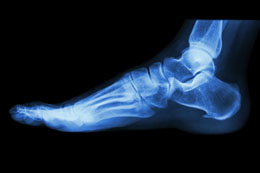What are ankle bone spurs? What are the causes of these bone spurs? Are there any symptoms? This Buzzle article provides answers to these questions.

Bone spurs, known as osteophytes in medical terms, are abnormal growths that are generally formed in the damaged or arthritic bones. They usually develop around the bone joints or tendons. Bone spurs are actually the result of our body's attempt to repair certain damage. When the body senses any damage or deterioration in a bone, it begins to create extra bone tissue in that area to strengthen the bone. The extra tissue around the bone then hardens to form bone spurs and can interfere with the natural range of motion of the joint. It may also pinch the nerves surrounding the bone and can result in trapped nerves.
What is Ankle Bone Spur?
Bone spurs can be formed along any bone in the body. However, spine, elbows, shoulders, and ankles are highly prone to develop bone spurs. A lot of wear and tear happens at the ankle joint, and hence, it is a common place for the formation of bone spurs. An ankle bone spur is a small outgrowth, smooth or pointed, that occurs on the ankle joint. It can develop along the bottom edge of the tibia or on the upper surface of the talus.
Causes
Ankle bone spurs are commonly caused by the condition known as osteoarthritis. Osteoarthritis affects the cartilage that is responsible for protecting the bone. As a result, the cartilage wears off, and over a period of time, the smooth surface of the cartilage may become rough causing friction between the bone and the cartilage, resulting in the formation of a bone spur. It can also be caused on account of an injury to the ankle. The body creates extra tissue to mend the damaged bones, eventually forming a bone spur.
Ankle bone spurs may be formed as a result of tight ligaments that put pressure on the feet. People who wear shoes that are too tight may develop bone spurs in the ankle. The long ligament that is present at the bottom of the foot becomes stressed and pulls on the heel. This causes the ligament to become inflamed, and in the body's attempt to mend this damage, a spur can develop at the bottom of the foot. Sometimes, the attachment of ligaments and tendons to the bones becomes calcified, which may result in the formation of a bone spur around the Achilles tendon.
Symptoms
Most bone spurs do not cause any symptoms, and hence go unnoticed. However, they are associated with pain, numbness, tenderness, swelling, or inflammation in the area where the bone spur is present. If the bone spur is pressing on muscles or other bones, it can cause the tissues in that area to break, causing swelling and pain in that area. Sometimes, an extra tissue develops, which tends to pad the existing bone spur. This results in the formation of corns and calluses.
Treatment
For minor condition, the treatment would involve taking ample rest, wearing proper-fitting footwear, application of ice packs, and using anti-inflammatory drugs to alleviate the pain.
If the spur is formed due to arthritis, then it can cause problems for the patient and can be very painful. In such cases, surgery is commonly recommended.
One type of surgery called 'cheiloctomy' can be performed to remove the bone spur and relieve the pain caused by it. Another common surgery called 'arthrodesis' can also be performed. In this surgical procedure, two bones on each end of the ankle joint are fused. Hence, the surgery is also known as joint fusion surgery. Some physical therapy may be recommended after the surgery for complete recovery.
Disclaimer:
This Buzzle article is for informative purposes only, and should not be used as a replacement for expert medical advice.


 Bone spurs, known as osteophytes in medical terms, are abnormal growths that are generally formed in the damaged or arthritic bones. They usually develop around the bone joints or tendons. Bone spurs are actually the result of our body's attempt to repair certain damage. When the body senses any damage or deterioration in a bone, it begins to create extra bone tissue in that area to strengthen the bone. The extra tissue around the bone then hardens to form bone spurs and can interfere with the natural range of motion of the joint. It may also pinch the nerves surrounding the bone and can result in trapped nerves.
Bone spurs, known as osteophytes in medical terms, are abnormal growths that are generally formed in the damaged or arthritic bones. They usually develop around the bone joints or tendons. Bone spurs are actually the result of our body's attempt to repair certain damage. When the body senses any damage or deterioration in a bone, it begins to create extra bone tissue in that area to strengthen the bone. The extra tissue around the bone then hardens to form bone spurs and can interfere with the natural range of motion of the joint. It may also pinch the nerves surrounding the bone and can result in trapped nerves.